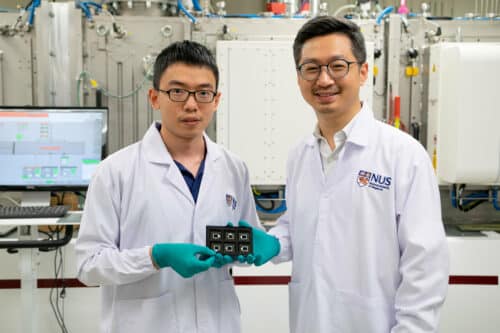Using innovative cyanate-integration technology, NUS scientists have developed a triple-junction perovskite/Si tandem solar cell with a record-breaking 27.1% efficiency.

Multi-junction solar cells are created by stacking multiple layers made from different photovoltaic materials that absorb different solar energy ranges to enhance efficiency. Despite their potential, current multi-junction solar cell technologies face challenges such as energy loss, which leads to low voltage and device instability during operation.
A National University of Singapore (NUS) team has developed an innovative triple-junction perovskite/Si tandem solar cell with a record-breaking power conversion efficiency of 27.1% over a one sq cm area. This is the highest efficiency achieved for such cells to date. The breakthrough was made possible by creating a new cyanate-integrated perovskite solar cell that combines stability and energy efficiency.
Researchers have successfully integrated cyanate into a perovskite solar cell for the first time, leading to the development of a state-of-the-art triple-junction perovskite/Si tandem solar cell. This new cell outperforms similar multi-junction solar cells in terms of efficiency and effectiveness.
Fabricating energy-efficient solar cell technology
In this research, the National University of Singapore (NUS) team explored the potential of cyanate, a novel pseudohalide, as a substitute for bromide in perovskite solar cells. The cyanate’s successful integration into the perovskite structure led to a more stable and efficient solar cell with a higher voltage. The team further demonstrated the enhanced performance of a triple-junction perovskite/Si tandem solar cell incorporating the cyanate-integrated perovskite, achieving a record-breaking efficiency of 27.1% in a controlled test environment. This breakthrough highlights the potential of cyanate as a viable alternative to halides in perovskite-based solar cells.
Next steps
The NUS team’s research on triple-junction perovskite/Si tandem solar cells shows a theoretical efficiency exceeding 50%, offering great potential for further improvements, particularly in space-constrained installations. The team is now focused on scaling this technology to larger modules while maintaining efficiency and stability. Future efforts will concentrate on innovations in the interfaces and composition of perovskite, which are crucial for advancing this technology.
Reference: Shunchang Liu et al, Triple-junction solar cells with cyanate in ultrawide bandgap perovskites, Nature (2024). DOI: 10.1038/s41586-024-07226-1







